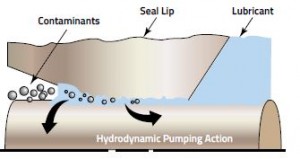
But how do PTFE rotary seals work? In this post, we’ll try to answer that question in more detail.
Rotary shaft seals work by squeezing and maintaining lubricant in a slim layer between the lip and the shaft. Sealing is aided by the hydrodynamic action caused by the rotating shaft, which creates a slight pump action.
Rotary shaft seals provide protection through two crucial functions. In most applications, the seal’s main function is to retain the bearing or system lubricant. Seals also work to exclude outboard material that can contaminate the system lubricant or directly damage the bearing.
The type of contamination the seal will need to exclude will depend on the application. The most common kinds of contamination are moisture, water and dry materials such as dust, sand, dirt or the particulates generated during manufacturing.
PTFE Rotary Seals and Lubrication
The seal’s ability to retain the system lubricant and exclude contaminants plays a vital role in the service life of equipment components like bearings and gears, and relies on the system lubricant. The seal can have a powerful impact on the life of the lubricant, reducing exposure to excessive frictional heat and excluding foreign material.
Typical petroleum oil has a useful life of 30 years at 86 degrees F (30 degrees C) if it isn’t contaminated with water or particulate matter.
But the same oil has a life of only one month at 212 degrees F (100 degrees C). As little as .002 percent water in oil lubrication can reduce ball bearing life by 50 percent, primarily through hydrogen embrittlement. Solid particles cause more rapid damage to the bearing race through high-localized stresses and increased frictional heat.
The sliding contact between the shaft and lip seal will create friction, increasing the contact temperature beyond the temperature caused by the bearings and other sources. Heat accelerates the breakdown of the oil and starts forming a varnish on the hot spots.
Over time, the varnish transforms into carbon and gets thicker as the surrounding oil loses lubricity. How quickly this happens is dependent on temperature. The deposit can leak and abrade the tip, causing leakage. The time to reach each stage is halved with each 18 degrees F (10 degrees C) increase in temperature.
The amount of frictional heat generated is a combination of many operating parameters. Shaft surface, internal pressure, operating speed, lubricant type and level, lip geometry and lip material are just a few conditions to consider.
It’s also important to note that these conditions are very interactive. For example, an increase in shaft speed will lead to an increase in sump temperature. If not vented, the rise in temperature will increase the pressure inside the housing.
The internal pressure will push on the seal lip and create additional force between the shaft and seal lip. In turn, the operating temperature under the seal lip will see a substantial rise in temperature and can cause premature seal failure within hours.
To learn more about PTFE rotary shaft seals and their history use and design, be sure to download the Gallagher Fluid Seals guide to rotary seals.

